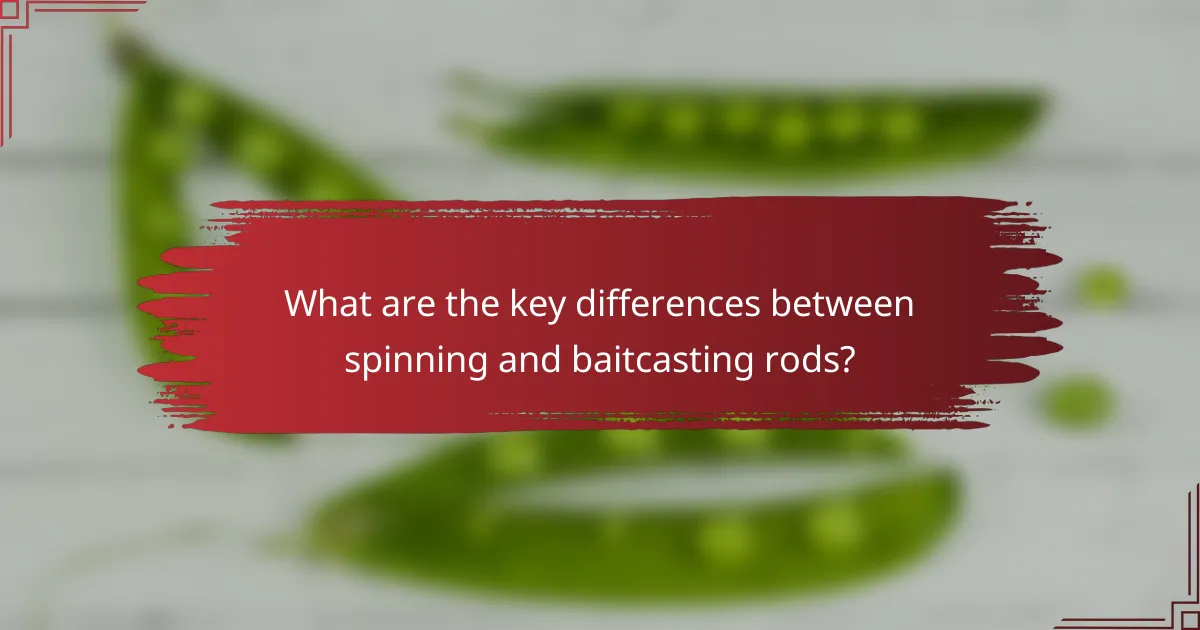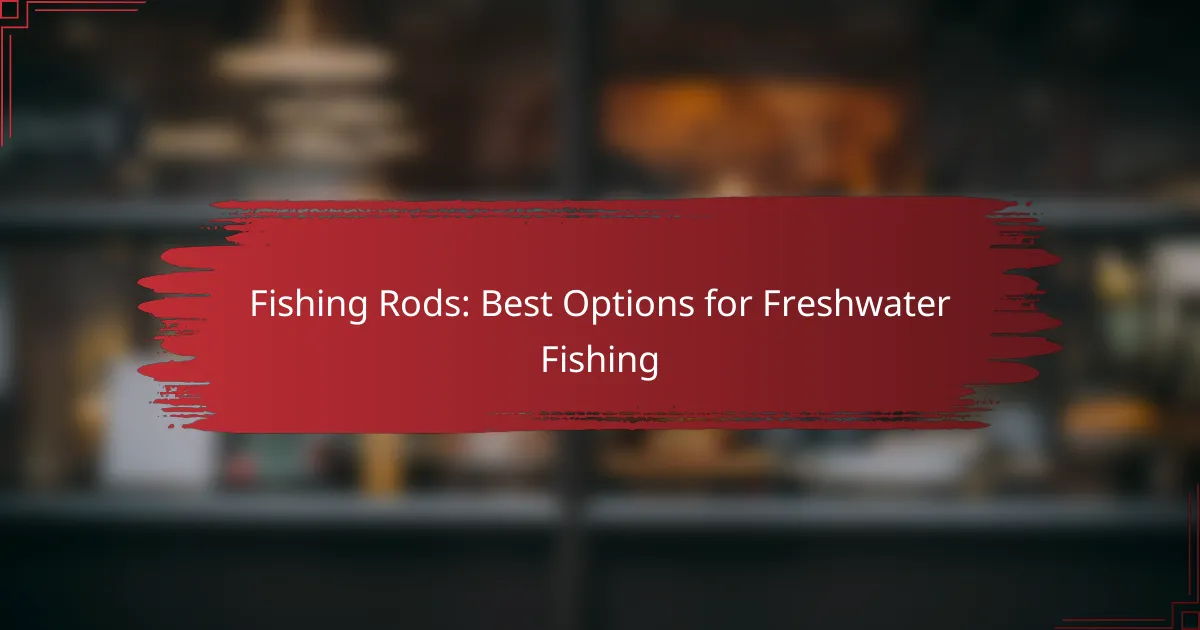When deciding between spinning rods and baitcasting rods, it’s essential to consider your fishing style and the species you aim to catch. Spinning rods provide versatility and are ideal for lighter lures, while baitcasting rods excel in precision for heavier lures, catering to more experienced anglers.

Which rod is better for freshwater fishing?
Choosing between spinning rods and baitcasting rods for freshwater fishing depends on your fishing style and target species. Spinning rods are generally more versatile, while baitcasting rods offer greater precision for experienced anglers.
Spinning rods for versatility
Spinning rods are ideal for a wide range of fishing techniques and conditions. They excel in light tackle applications and can handle various lure types, making them suitable for catching species like panfish, trout, and bass.
These rods are easier to use for beginners due to their simple design and the ability to cast lighter baits. When fishing in areas with limited space or when targeting skittish fish, spinning rods provide the flexibility needed to adapt to different situations.
Baitcasting rods for precision
Baitcasting rods are designed for accuracy and control, making them a preferred choice for experienced anglers targeting larger species such as pike and bass. They allow for precise lure placement and better line management, which is crucial when fishing in heavy cover.
While baitcasting rods can be more challenging to master, they offer advantages in terms of sensitivity and the ability to handle heavier lines and baits. Anglers should practice casting techniques to avoid backlash and maximize their effectiveness.
Target species considerations
Your choice between spinning and baitcasting rods should also depend on the species you aim to catch. For smaller fish like trout and crappie, spinning rods are often more effective due to their versatility and ease of use.
In contrast, if you are targeting larger freshwater species such as bass or catfish, baitcasting rods provide the strength and precision needed for successful catches. Consider the size and behavior of your target species when selecting the appropriate rod type for your fishing adventures.

When should I use a spinning rod?
A spinning rod is best used when targeting lighter lures and finesse techniques. It offers versatility and ease of use, making it suitable for various fishing conditions and species.
Best for light lures
Spinning rods excel with lighter lures, typically ranging from 1/32 oz to 1/2 oz. Their design allows for better casting distance and accuracy with these lighter weights, making them ideal for species like trout and panfish.
When using light lures, consider the rod’s action and power. A medium-light action rod provides the sensitivity needed to detect subtle bites while still having enough backbone to handle a fight.
Ideal for beginners
Spinning rods are particularly beginner-friendly due to their straightforward mechanics. They are easier to cast and control, reducing the learning curve for new anglers.
For those just starting, a spinning setup is less prone to tangles and backlash compared to baitcasting rods. This makes it a great choice for practicing casting techniques without the frustration of frequent snags.

When should I use a baitcasting rod?
A baitcasting rod is ideal for anglers looking to cast heavier lures with precision. These rods are designed for more controlled casting, making them suitable for specific fishing techniques and experienced users.
Best for heavy lures
Baitcasting rods excel when using heavy lures, such as jigs, swimbaits, or large crankbaits. Their construction allows for better handling of the weight and provides the necessary backbone to set hooks effectively.
When targeting larger species like bass or pike, a baitcasting rod can improve your chances of success. The ability to cast heavier tackle accurately means you can reach deeper waters or navigate through dense cover more efficiently.
Preferred for experienced anglers
Baitcasting rods are generally favored by more experienced anglers due to their learning curve. Mastering the use of a baitcaster requires practice, as it involves managing the spool and preventing backlash during casting.
For those who have honed their skills, baitcasting rods offer enhanced sensitivity and control. This makes it easier to detect subtle bites and react quickly, which is crucial in competitive fishing scenarios.

What are the key differences between spinning and baitcasting rods?
Spinning rods and baitcasting rods differ primarily in their design and intended use, affecting how anglers cast and manage their lines. Spinning rods are generally easier to use for beginners and are versatile for various fishing techniques, while baitcasting rods offer greater precision and control for experienced anglers.
Reel placement and mechanics
Spinning rods feature a reel that is mounted underneath the rod, allowing for a more natural grip and easier line release. This design makes them suitable for lighter lures and finesse techniques, as the line flows smoothly off the spool.
In contrast, baitcasting rods have the reel positioned on top, which allows for better control over heavier lines and lures. The mechanics of baitcasting involve a thumb control system that can be adjusted for different casting distances and techniques, making them ideal for targeting larger fish.
Line management and casting distance
Spinning rods excel in line management, particularly with lighter lines and lures, making them effective for casting short to medium distances. The open-faced design minimizes tangles and backlashes, which is beneficial for novice anglers.
Baitcasting rods, however, provide superior casting distance and accuracy when using heavier lines. They require more skill to manage, as improper technique can lead to backlash. Anglers should practice adjusting the brake system to optimize line control and casting performance.

How do I choose between spinning and baitcasting rods?
Choosing between spinning and baitcasting rods depends on your fishing style, skill level, and target species. Spinning rods are generally easier for beginners and versatile for various techniques, while baitcasting rods offer better accuracy and control for experienced anglers.
Consider your fishing style
Your fishing style significantly influences whether you should use a spinning or baitcasting rod. If you prefer finesse techniques, such as drop shotting or using light lures, spinning rods are typically more effective. On the other hand, if you often fish in heavy cover or use larger baits, a baitcasting rod can provide the necessary strength and precision.
Additionally, consider the types of fish you are targeting. For species like trout or panfish, spinning rods are often the go-to choice, while bass and pike anglers may favor baitcasting setups for their ability to handle heavier lines and lures.
Evaluate rod length and action
Rod length and action play crucial roles in your decision between spinning and baitcasting rods. Spinning rods usually range from 6 to 7 feet, offering a good balance for various techniques. Baitcasting rods can be slightly longer, often between 7 and 8 feet, which helps with casting distance and accuracy.
Action refers to how much of the rod bends when pressure is applied. Fast action rods bend mostly at the tip, providing quick responsiveness, which is beneficial for baitcasting. Moderate action rods, common in spinning setups, offer more flexibility, making them suitable for lighter lures and finesse techniques. Choose based on your preferred fishing methods and the types of lures you plan to use.

What are the top brands for spinning and baitcasting rods?
The leading brands for spinning and baitcasting rods are Shimano and Daiwa, known for their quality, performance, and innovation. Each brand offers a range of products tailored for different fishing styles and preferences, making them popular choices among anglers.
Shimano for spinning rods
Shimano is renowned for its spinning rods, which are designed to provide sensitivity and strength. Their rods often feature lightweight materials and advanced technology, allowing for better casting distance and accuracy.
Popular Shimano spinning rod models include the Shimano Stradic and the Shimano Clarus, both of which are well-regarded for their durability and performance. When choosing a Shimano spinning rod, consider the rod length and action that best suits your fishing style, whether it’s freshwater or saltwater.
Daiwa for baitcasting rods
Daiwa excels in producing baitcasting rods that offer precision and control, making them ideal for targeting specific species. Their rods are often equipped with ergonomic grips and lightweight designs, enhancing the overall fishing experience.
Notable models from Daiwa include the Tatula and the Zillion series, which are favored by many competitive anglers. When selecting a Daiwa baitcasting rod, pay attention to the gear ratio and line weight capacity, as these factors significantly impact your fishing technique and success.

What are the emerging trends in fishing rod technology?
Emerging trends in fishing rod technology focus on enhancing performance, durability, and user experience. Innovations include the use of advanced materials, smart technology integration, and improved ergonomic designs to cater to various fishing styles.
Advanced Materials
Fishing rods are increasingly made from high-modulus carbon fiber and composite materials that offer greater strength while remaining lightweight. These materials enhance sensitivity, allowing anglers to detect even the slightest bites. Additionally, advancements in resin technology improve the rods’ resistance to wear and environmental factors.
Smart Technology Integration
Smart fishing rods equipped with sensors and connectivity features are gaining popularity. These rods can track casting distance, monitor fish activity, and even provide real-time data to smartphones. This integration helps anglers optimize their fishing strategies and improve their overall success rates.
Ergonomic Designs
Modern fishing rods are designed with ergonomics in mind, featuring comfortable grips and balanced weights to reduce fatigue during long fishing sessions. Many rods now offer customizable components, allowing anglers to adjust the length and action to suit their personal preferences and fishing conditions. This focus on user comfort enhances the overall fishing experience.



